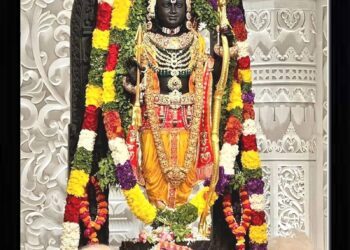The Bara Imambara, located in the heart of Lucknow, Uttar Pradesh, is a magnificent architectural masterpiece and an iconic symbol of Mughal-era design. It stands as a testament to the grandeur and cultural richness of the Awadhi region and is one of the most popular tourist destinations in northern India. Built by the Nawab of Oudh, Asaf-ud-Daula, in 1784, it was constructed primarily for the purpose of providing employment to the people of Lucknow during a time of famine. Over time, however, it has come to represent the zenith of Mughal architecture and the luxurious lifestyle of the Nawabs.

The Bara Imambara is an excellent example of Indo-Islamic architecture. The structure, with its imposing size and intricate design, is a blend of Mughal, Persian, and Awadhi architectural styles. The main building features a large central hall, which is one of the largest arched constructions without support beams in the world. The hall’s roof, which spans an impressive 50 meters, is constructed entirely without the use of iron or steel, a remarkable feat of engineering for the time. This makes it a unique architectural achievement.

The building is an imposing two-story structure made of red brick, with a central dome at its highest point. The central hall is complemented by a series of smaller rooms, corridors, and staircases that add to the overall mystique of the site. The intricate carvings, arches, and jharokhas (overhanging enclosed balcony) are a marvel of craftsmanship, showcasing the expertise of the artisans involved in its construction.
One of the most fascinating features of the Bara Imambara is the Bhulbhulaiya, a labyrinthine network of narrow corridors and staircases inside the monument. The maze was designed to confuse and disorient visitors, a unique aspect of the structure. It is said that even the people who built it sometimes got lost inside. The labyrinth leads to a roof that offers panoramic views of the city of Lucknow. Exploring this maze is a thrilling experience for visitors, adding an element of adventure to the historic visit.

Adjacent to the Bara Imambara is the Asfi Mosque, an impressive structure with a large central dome and two smaller minarets. The mosque is a fine example of Mughal architecture and adds to the spiritual atmosphere of the site. It is often used for prayers and serves as an important religious site for the local Muslim community.
The Bara Imambara holds historical significance beyond its architectural beauty. It was constructed during the reign of Nawab Asaf-ud-Daula, a ruler who is remembered for his generosity and benevolence, particularly in the face of widespread famine. In addition to its religious and cultural value, the Bara Imambara also played a role during the Indian Rebellion of 1857, as it became a center of activity for the rebels.

Today, the Bara Imambara stands as a reminder of the grandeur of the Mughal and Awadhi empires. It continues to attract tourists and historians from around the world, who marvel at its design and the skill of the artisans who built it. With its unique features like the Bhulbhulaiya and the Asfi Mosque, the Bara Imambara is not only a significant historical landmark but also a cultural treasure that continues to captivate visitors.


















